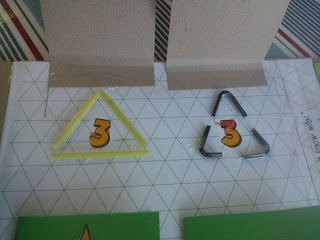Assalamo aleykum,
Alhamdulillah we managed to wrap up some nice activities about squares and rectangles. I had originally thought of having a lapbook about quadrilaterals (with trapezoids, rhombuses and parallelograms too) but there wasn't going to be enough space to explore the difference between all of those shapes. So we stuck with the easier ones for the time being. It is very similar to our Triangles Lapbook, and again it all started with an Amazon box I had received a book in (alhamdulillah for saving them!):
The colour scheme is a little out there ... eh eh. Anyway, the first part is a collection of some creative bits and bobs: Yusef cut out and coloured his own cardboard shapes (and made some holes in them so they could breathe... bless him!) and then we built a robot using squares and rectangles (the base of the robot was one we had left from this build your own robot craft kit, but it can easily be recreated).
On the middle section we built the shapes with cut drinking straws, the straight parts for sides and the bendy bits to make angles, and we made a little flap inside each shapes under which we hid the answer to the questions:
(^^In the middle of the assembly work, Yusef decided he had to spell my name with sticky letters, so I included in the lapbook. Apparently my name is "Mommi", see above, bottom right <3 masha'Allah)
The third part is the one that is full of surprises. On the outer part of the horizontal flaps we stuck 3 minibook we had made, 2 of them are collections of geometrical puzzles - intended for much older people - but that I use to let Yusef practise his ability to identify the shapes (those that are more apparent of course) and to count them, within his ability of course:
Unlike the similar minibook we made about triangles,most of these puzzles each featured more than one kind of shape, s he had to be careful to colour only the one that was relevant to the exercise:
The 3rd minibook features pictures of objects that can be either square or rectangular, labelled with the object name that Yusef traced, masha'Allah. I do realise all objects are 3D, so I tried to choose flat things, to make it less obvious to a 4 year old:
Under the flaps, we practised some "measuring in non conventional units". I simply printed out some grid paper (medium and large from here ) on white and coloured paper and drew some shapes for Yusef to fill in with squares, cut from coloured paper. He then counted how many squares were needed to make each shape and wrote the numbers. (Barak Allahu feek to Aisha, my sister in Islam and "home educator extraordinaire" - masha'Allah - for telling me about non conventional units of measure!!!... I had no idea)
During a recent conversation with my (birth) sister, I was reminded about PATTERNS and though "We haven't done patters in ages!!!" so we devoted the last bits of space left (under the horizontal flaps) to patters, made with squares cut out of the leftover card we had used:
This was good fun alhamdulillah :)
Everything can easily be found online/reproduced, however, if you want to save time, here is what I used (they are NOT looking very professional, please bear with me...):
Various labels (including blank speech bubbles to add to the finished work the best quotes from your child as he/she was making it)
















































